BY MIKE METTLER
Just when you think Steven Wilson is at the surround sound pinnacle, he ratchets it up another level.
I first heard The Raven That Refused to Sing (and Other Stories) at a playback session in New York’s Avatar Studios back on January 15, 2013. And this is how you know I’m super-hardcore dedicated to championing the glories of 5.1, since January 15 was literally the day after I had returned from a full, exhilarating but exhaustive week at CES in Las Vegas. But nothing was gonna stop me from hearing Raven in the best environment possible.
Right from the outset of that listening session, I (and everyone in the room) knew Raven was something special. Since then, I’ve played the album countless times, and I can unequivocally say that the 96/24 LPCM Blu-ray mix of The Raven That Refused to Sing (and Other Stories) has wiped the surround slate clean and set the benchmark anew. Yes, it’s that bloody good.
(Oh, sure, you can also select the DTS-HD Master Audio 5.1 option if you wish, but 96/24 is the way to go. And, naturally, there’s also a wonderful-sounding vinyl release if you want to take Raven out for a double-disc 180-gram spin in stereo.)
One of the reasons Raven cuts such a wide aural swath is that the man and his associate producer and recording engineer, Alan Parsons, captured the core of Wilson’s Grace for Drowning touring band performing live off the floor at East West Studios in Los Angeles in September 2012. (You can watch the band at work in the “Studio Documentary” that was shot by longtime Wilson visual collaborator Lasse Hoile in the Blu-ray’s Bonus section.) The intuitive muscle of that band, buttressed by the addition of lead guitarist Guthrie Govan, comes through in the improvs and overall natural mastery of A-level material.
Raven commences with the 12-minute hard-charger “Luminol,” with a Nick Beggs-driven bass line leading the way while Guthrie’s guitar swatches ping-pong in the fronts and Theo Travis’s flute lines swirl around your head until the instrumentation halts and a massive, layered vocal bed swoops down on you. And then Wilson deploys the King Crimson MKII mellotron as Beggs’s bass returns to the center stage (and the subwoofer channel) before giving way to keyboard wiz Adam Holzman. The second movement begins with an almost buried “Planet Caravan”-like guitar line setting the stage for the verses. Drummer Marco Minnemann deftly Bruford-izes a Yes-like passage that’s anchored in the rear channels, and there’s an elegiac vocal harmony section that would make Crosby, Stills and Nash proud. And as I noted in my Top 25 Songs of 2013 list, “Luminol” is officially my personal favorite benchmark 5.1 demo track.
The tone downshifts a bit with Track 2, “Drive Home.” On the verses, Wilson’s near-falsetto vocal warble weaves around his acoustic guitar figures, while the track opens up wide on the choruses thanks to the all-channel reach of the London Symphony Orchestra string section, conducted by Dave Stewart (as in Hatfield and the North/National Health Dave Stewart, not onetime Eurythmic Dave Stewart). In November 2013, Wilson released a Drive Home Blu-ray EP that includes hi-res live tracks, a new track (“The Birthday Party”), remixes, and video footage, and it’s well worth picking up as your official Raven companion.

Holy Thinker: Wilson contemplates Govan’s licks in the East West Studios sessions in Los Angeles, September 2012.
Track 3, “The Holy Drinker,” opens with shimmery, Twin Peaks-ian keyboard riffage that leads into snarling guitar, a left-turn cool down, and an eventual full-channel pummeling that’s a twisted cousin to the sinister undertones of Drowning’s “Index.” (And, uh, those outro, rear-channel howls? Chilling.)
“The Pin Drop,” Track 4, is another tone break, commencing with a dreamy, clockwise, Gilmour-ian guitar line as Wilson vocalizes high notes in the center channel before a full-band, full-channel assault hits you at 1:15, with drummer Minnemann just tearing it up in the rears and Travis’s lofty sax solo wafting all around you.
The epic Track 5, “The Watchmaker,” begins plaintively, Wilson’s guitar delayed front to back as he starts singing the verses, his doubled vocal lines emphasized in the rears. The aforementioned mellotron makes a welcome return to echo a vocal lilt before the middle movement commences and picks up the pace, Minnemman’s cymbal work sharp in the rears with the rest of the band filling in — Travis’s flute and Holzman’s organ setting the stage for Govan’s down-the-middle overdriven solo. Another movement commences with lush, overlapping harmonies until mellotron and band absolutely envelop and crush you with their abject power.
Raven’s titular last call, Track 6, balances yearning piano, vocal pleading, wistful clarinet, and the rise, fall, and rise of the strings. It’s Wilson’s most heartfelt, raw-emotion-invoking song since Porcupine Tree’s Stupid Dream closer, “Stop Swimming.” After seeing “Raven” performed in live quad at the Nokia Theater in Times Square in NYC back on April 26, 2013, Holzman’s wife, ace guitarslinger Jane Gitter, told me backstage, “It made me cry.” (Me too — but, uh, don’t tell…)
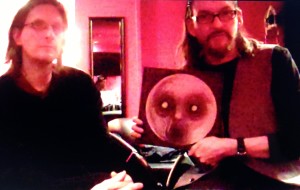
Raven-ettes: SW & MM & Raven vinyl, in a still from our video interview that will post in early 2014.
The breadth and scope of Raven represent Steven Wilson at the height of his creative powers, where surround sound music and mixing has reached a heretofore unheard aural apex. Our ever-searching ears are lucky to be consistently challenged and rewarded by this man’s muse.
What”s next for the Surround King? Well, I spoke with Wilson recently about his colossally satisfying 5.1 Blu-ray mix for Yes’ Close to the Edge, his upcoming surround projects, and his view of the future of high-resolution audio, and you’ll see the full breadth of our Q&A in The SoundBard Interview in early 2014. Until then — happy immersive listening!
Tags: Adam Holzman, Alan Parsons, Close to the Edge, Dave Stewart, Drive Home, Guthrie Govan, Jane Getter, King Crimson, Lasse Hoile, London Symphony Orchestra, Marco Minnemann, mellotron, Nick Beggs, Porcupine Tree, Steven Wilson, The Raven, Theo Travis, Yes

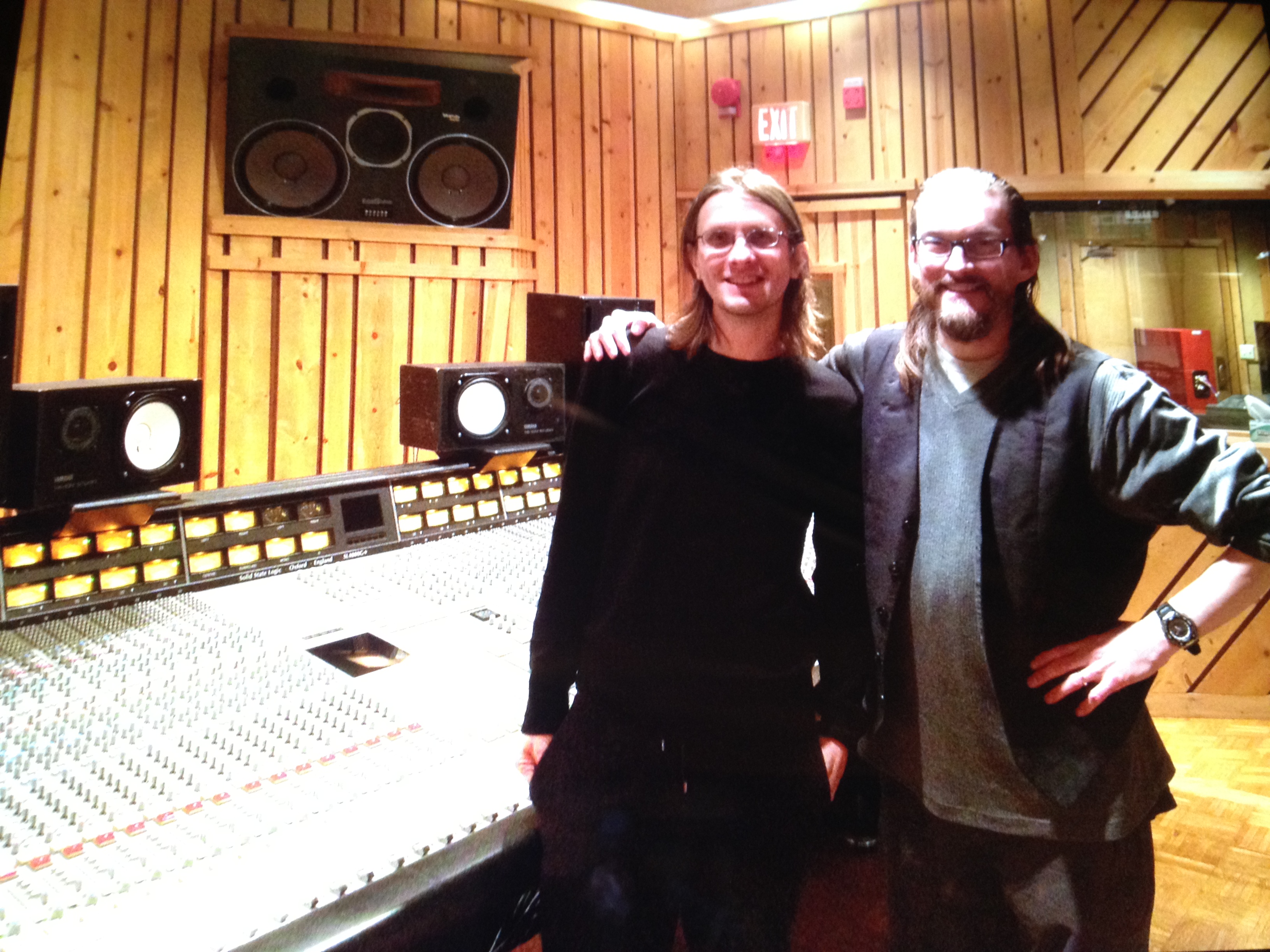
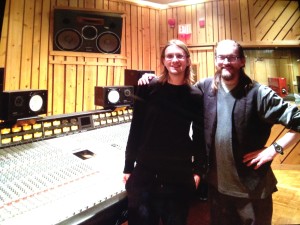
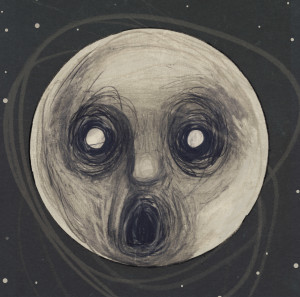

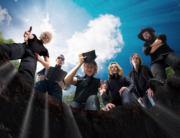
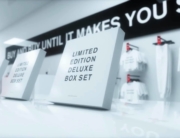


Great Article! I’m a big fan of Steven Wilson, P. Tree as well as 5.1 surround music. I have a pretty extensive collection of 5.1 music (mostly rock) and don’t get why it has such a poor following. Argh!
Question: (I think I know the answer) If I have Close to the Edge in original vinyl, remastered vinyl, and remastered CD, can I justify spending $30 for the surround mix? It’s not so much that I’m cheap, but I’m a music hoarder so my vinyl/CD collection is an expensive habit. If I knew that the 5.1 mix was different enough (more immersive ) than the remastered CD I’d go for it. I know Steven Wilson is the 5.1 wizard so I expect you’re going to suggest “go for it!” just wanted your opinion.
Hi Andrew,
Thanks for the kind words. Without question, you should obtain the Blu-ray version of Close to the Edge in 5.1 IMMEDIATELY, if not sooner. (And make sure you go for Blu-ray over DVD-Audio here.) It is one of THE most immersive 5.1 mixes you’ll ever hear. Just wait until you’re fully enveloped by Rick Wakeman’s church-organ section on the title track, for starters…
In fact, I recently interviewed Steven Wilson about what he did for the CTTE in 5.1 mix. That piece will appear in the April 2014 issue of Sound & Vision, which goes on sale February 28. I will post a longer version of that interview right here on SoundBard on February 26.
MM
The SoundBard
Dear SoundBard,
Just placed my order for the Yes Blu-ray! Thanks for the advice.
Keep up the good work!
cheers,
Andrew
[…] 90s recordings is not, and people want things to sound a certain way. Even on my own last record [The Raven That Refused to Sing (and Other Stories)], I was looking for that kind of dryer, almost ’70s […]